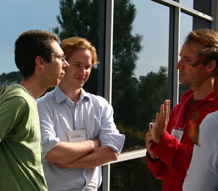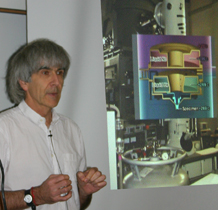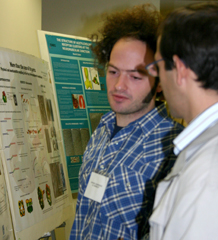

Organize It and They Will Come
By Mika Ono
Little did Scripps Research Institute investigators Bridget Carragher, Clint Potter, and Ron Milligan know when they started a cryo-electron microscopy (EM) course six years ago that it would turn into one of the premier workshops in the world, recently drawing nearly 140 people to the Scripps Research Institute's Center for Integrative Molecular Biosciences (CIMBio).
The November 2009 conference, titled "Workshop on EM Structure Determination of Challenging Macromolecules," consisted of six grueling but exhilarating 13-hour days of classes.
"It was fantastic," said Carragher. "It was the biggest conference yet and the science was outstanding. We discussed vital issues in the field and made progress on them."
Organized under the auspices of the National Resource for Automated Molecular Microscopy at CIMBio, the conference not only offered advanced training in cryo-EM molecular structural determination to graduate students and postdocs, but also acted as a gathering place for leading experts in the field.
Participants—who came from across the United States, as well as Europe, Asia, and Australia—attended theoretical lectures in the mornings followed by practical demonstrations and panel discussions in the afternoon. Evenings were filled with poster presentations by student participants and research talks by instructors.
"The quality of the participants was very high, which led to lively discussions," Carragher said. "Also, the lecturers were incredibly generous with their time. Many stayed for the full conference."
One instructor, EM pioneer Joachim Frank of Howard Hughes Medical Institute and Columbia University, commented in a brief break between sessions: "This is the place to be. It's among the best meetings in the world for people in the field."
Filling in the Gap
Why all the excitement about the field of cryo-electron microscopy? The EM technique sits squarely between the established fields of x-ray crystallography, on the one hand, which can solve protein structures to exquisitely high resolution, and cell biology, on the other, which focuses on the larger picture of where those proteins are in a cell.
"With cryo-EM, we can look at how solved protein structures perform critical tasks within a cell, such as transportation and replication," said Carragher. "That's what the technique is all about from our perspective—putting together the parts of a working machine."
Milligan notes that cryo-electron microscopy is currently the only technique that can be used to directly visualize macromolecular machines within a cell.
"You simply can't grow crystals of things whose conformation changes by the second," he noted. "So, over the last 30 years, methodologies of looking at these pieces frozen in their native state, naked and cold, have developed."
While interest in cryo-electron microscopy burgeoned over the last decades, training opportunities had remained largely limited to an oversubscribed course held every other year at the European Molecular Biology Laboratory in Heidelberg, Germany.
So, in 2003 the CIMBio team decided to fill the gap with a course of its own, offered in the off years for the Heidelberg course and aimed primarily at scientists in the United States and Pacific Rim to balance the Heidelberg course's European roots.
"We did very little advertising and got a huge response," said Potter. "We put out one e-mail, received 80 applications, and closed the course [soon afterward]."
A Growing Concern
Since then, the CIMBio conference has grown each time it has been held, in 2005, 2007, and 2009. This year, a tent was put up outside the building to accommodate all of the participants for their meals and coffee breaks.
The course has also grown in terms of scientific scope. This year's conference focused on the latest developments for handling macromolecules that present unique challenges to existing EM techniques. Topics included improvements in specimen preparation, imaging, processing, and reconstruction.
"The conference is unusual in concentrating on techniques, rather than results," noted Carragher.
Also this year, a partnership with the Scripps Research Joint Center for Innovative Protein Technologies added another dimension to the discussions. As a result of the new collaboration, one day of the workshop centered on EM for membrane proteins.
Making the expanded 2009 conference possible were sponsors including Jcimpt Complexes, the National Institutes of Health's National Center for Research Resources, Agouron Institute of The Agouron Foundation, Scripps Research, FEI Company, Gatan Inc., Direct Electron, and Ted Pella, Inc.
Carragher also credited Administrative Assistant Lorraine Lathrop for her work helping to orchestrate the proceedings. "Feeding all those people for six days is not trivial," Carragher said wryly.
In the end, conference participants were sustained through the conference's grueling schedule and intellectual rigor not only by breakfast, lunch, and dinner (and, of course, coffee), but also by the new knowledge and friendships that will feed their work for many years to come.
For more information on the course, see http://nramm.scripps.edu/seminars/2009/cryoem/. For more information on CIMBio, see http://cimbio.scripps.edu/.
Send comments to: mikaono[at]scripps.edu

Participants came from around the world to attend the advanced workshop in EM structure determination.

Scripps Research Professor Nigel Unwin was among the experts leading seminars on vital issues in the field.

The science sparked lively discussions from early in the morning to late at night.
